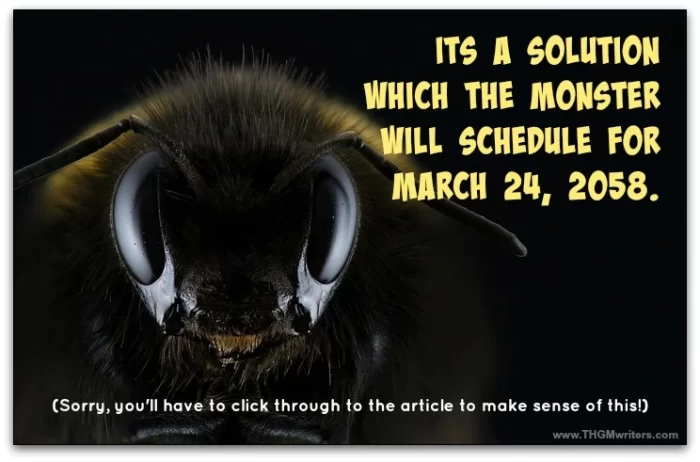The Grammar Monster doesn’t like what he sees in business documents. Let’s publicly flog the worst offending grammar errors.
I edit a lot of business documents, from blog posts to case studies, from book manuscripts to press releases. It’s funny how the same errors repeat themselves from document to document, from client to client. Here are some of those grammar errors I see the most.
Most common grammar errors in business writing (tap or click for a sneak peek)
What are the most common grammar errors in business writing?
- Missing hyphen in compound adjectives
- Broken time machine
- Confusing that and which
- Confusing its and it’s
- There can be no solution (without a problem)
Missing hyphen in compound adjectives
People ask: “Is data-driven hyphenated?” “Should follow-up be hyphenated?” “Is there a hyphen in trend-setting”? This is pretty simple. Sometimes two words are used as one, for instance, as an adjective. In those cases, you need a hyphen to make them into one word.
follow-up: This is an adjective, as in “He placed a follow-up call.” It describes “call”.
follow up: This is an action, where “follow” is a verb. “Let’s follow up with some more customers to see if they need more doodadders.”
trend-setting: This is an adjective. It describes a person or a nightclub or a city or something.
trend setting: This is an action, which one would not normally use. (“Look at the trend setting the table!” I don’t think so.)
trendsetting: This is also an adjective, as above.
data drive: This is a thing. Data is an adjective describing the noun “drive”.
data-driven: This is an adjective describing something else, possibly your marketing plan or your inventory strategy.
Broken time machine
Quiz time! What is wrong with this sentence?
The next meeting will be scheduled for March 24, 2058.
The date is wrong. How could you know that the date is wrong? Simple, it says that the meeting will be scheduled, so any date is wrong. If it has not yet been scheduled, there is no date. If a date is already identified, the scheduling has to be in the past tense.
Here are two correct ways to rewrite that sentence:
- The next meeting will be held on March 24, 2058.
- The next meeting has been scheduled for March 24, 2058.
You see, the meeting is in the future. The scheduling of the meeting is in the past. Unless you’re a Time Lord.
 Confusing that and which
Confusing that and which
- French fries that don’t get eaten must be thrown away.
- French fries which don’t get eaten must be thrown away.
- French fries, which don’t get eaten, must be thrown away.
Which sentence is correct?
The first sentence refers to certain French fries – specifically, those that don’t get eaten. They have to be thrown away.
The second sentence means…well, actually, it doesn’t mean anything.
The third sentence refers to French fries in general. Apparently French fries don’t get eaten, so they have to be thrown away. But if nobody eats French fries, why are they still on your menu?
Confusing its and it’s
This one is pretty simple, and yet we are all tempted to get confused. Here’s the rule: It’s is short for “it is”. If you can’t replace “it’s” with it is, then it’s its. Got that?
OK Let’s try some fun examples. Which of the following is correct?
- It’s time to go to bed.
- Its time to get up.
- Its OK, it’s just a monster under the bed playing it’s saxophone.
If you need help, ask the monster.
There can be no solution
Before you think that I’m being a real downer, let me clarify. There cannot be a solution without a problem. Until a problem is identified, there can be no solution.
You’ll have plenty of people offering to sell you their “solutions”. What they are really selling is software, systems, packages, services or apple pies. Hint: until you say you are hungry, an apple pie is not a “solution”. For instance, if a salesperson brandishes an apple pie and calls it a solution, how will that help your desperate need to pee.
When salespeople use the word “solution” that usually means they don’t have a clue what you need, but would you please buy their product anyway. At best, the word “solution” is a sign of laziness. </rant>
More business grammar errors?
These are just some of the business grammar errors I see all the time. Did I say this would be a “Top 10” list? Well, OK. I am sure you have plenty of your own grammar mistakes you could add to make this 10. So, please feel free to use the rant box below. Just be polite, don’t mention any politicians by name…and try to use proper grammar.
/div>


Hi David,
Great grammar lesson. We do see lots of errors online for sure, and we all need little reminders.
By the way, do you know that ONLY Americans thinks that fries are French? LOL. It’s because they’re not. Fries are Belgian.
“Let’s publicly flog the worst offenders.”
^ David, you make me laugh!
When I clicked on the headline, I expected to see examples of people using there, their and they’re wrong.
But you went deep, brother! Nice job.
Brent